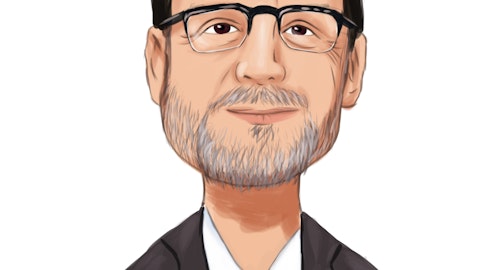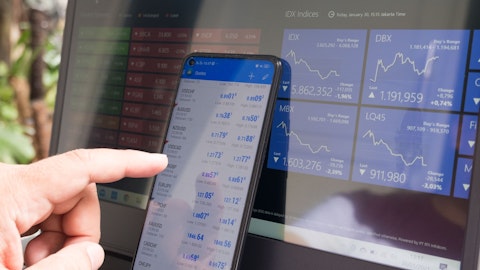Tucows Inc. (NASDAQ:TCX) Q4 2023 Earnings Call Transcript February 22, 2024
Tucows Inc. isn’t one of the 30 most popular stocks among hedge funds at the end of the third quarter (see the details here).
Monica Webb: Welcome to Tucows Fourth Quarter 2023 Management Commentary. We have prerecorded prepared remarks regarding the quarter and outlook for the company. A Tucows-generated transcript of these remarks, with relevant links, is also available on the company’s website. In lieu of a live question-and-answer period following these remarks, shareholders, analysts and prospective investors are invited to submit questions to Tucows management. Please submit questions via email to ir@tucows. com until Thursday, February 29th. Management will either address your questions directly or provide a recorded audio response and transcript that will be posted to the Tucows website on Tuesday, March 12th, at approximately 4 p. m. Eastern time.
We would also like to advise that the updated Tucows Quarterly KPI Summary, which provides key metrics for all of our businesses for the last eight quarters, as well as for full years 2021, 2022 and 2023, and also includes historical financial results is available in the Investors section of the website along with the updated Ting Build Scorecard and Investor Presentation. Now for management’s prepared remarks: On Thursday, February 22, Tucows issued a news release reporting its financial results for the fourth quarter ended December 31, 2023. That news release and the Company’s financial statements are available on the Company’s website at tucows. com under the Investors section. Please note that the following discussion may include forward-looking statements, which are subject to risks and uncertainties that could cause actual results to differ materially.

These risk factors are described in detail in the Company’s documents filed with the SEC, specifically the most recent reports on the Forms 10-K and 10-Q. The Company urges you to read its security filings for a full description of the risk factors applicable to its business. I would now like to turn the call over to Tucows President and Chief Executive Officer Elliot Noss. Go ahead, Elliot.
Elliot Noss: Thanks, Monica. We finished 2023 with positive momentum in all of our businesses. Tucows Adjusted EBITDA for 2023 outside of Ting was $59.6 million and with Ting was $15.5 million, at the higher end of our annual guidance range. This was driven by robust growth from Wavelo and consistent performance of Tucows Domains, and offset by our continued investment in Ting. Tucows consolidated revenue grew 10% year-over-year, and a strong finish to the year helped drive Tucows operating cash flow to $9 million in the fourth quarter, up from $2.9 million in Q4 of last year. We also repaid a further $11.5 million on the balance of the non-Ting syndicated loan this quarter, which takes us to $28 million paid down in 2023. Now that we’ve continued deleveraging and are squarely focused on addressing the financing challenges of the Ting business, which spilled over to TCX we are more and more getting back to Tucows being a cash generating machine.
Which is the right place to be in today’s macroeconomic environment. Again this year we’ve authorized a buyback program for up to $40 million in Tucows stock. We do this every year, whether or not we can foresee using it at the time we do the authorization. This is a formality. Now we’ll hear from the heads of each business, as well as from our CFO, Dave Singh, who will cover our financial results in detail. The first speaker is Dave Woroch, Chief Executive Officer, Tucows Domains. Go ahead, Dave.
See also 12 Best Marijuana Stocks To Invest In and Top 20 Most Valuable Travel Companies in the World.
Q&A Session
Follow Tucows Inc (NASDAQ:TCX)
Follow Tucows Inc (NASDAQ:TCX)
Dave Woroch: Thanks, Elliot. As we close out fiscal 2023, I’m particularly pleased that Tucows Domains grew revenue and gross margin, on a quarter-over-quarter basis, through successive quarters of 2023. Our core business is healthy and we’re rolling out new products for our resellers. And importantly, Tucows Domains continues to generate cash for the Company that is being used to pay down the debt and build the runway for Tucows’ long-term growth. In Q4, we saw slight gains across all our top level metrics, including domains undermanagement and transactions. Revenue for Domain Services for the fourth quarter was $61.8 million, up 2.5% from $60.3 million for the same quarter last year. Gross margin was $18.9 million, also up 2.5% from the same quarter last year.
And Domain Services’ Adjusted EBITDA,which was $10.8 million in the fourth quarter, was up 2% from Q4 of last year, as we continue to be attentive to managing expenses. The results were driven by an increase in the number of transactions in Q4, up 2%; and domains under management that were up slightly year-over-year. I would like to highlight that within our industry there is a range in the quality of new domains being registered, and our growth continues to be concentrated in higher quality and legitimate domain registrations. Looking at the results from the segments of our business; in our Wholesale channel, revenue for Q4 was up 2% compared to Q4 of last year, and gross margin was essentially unchanged year-over-year. Within the Wholesale channel, Domain Services’ gross margin was up 4% in Q4 compared to the same period last year, while Value-Added Services’ gross margin was down 8%.
I’ll note that the decline in the domains aftermarket that I covered in the last couple of quarters is no longer a factor for Value-Added Services. The Q4 decline in Value-Added Services was actually a result of something we periodically do at the resellers’ request which is to move their customers from the Wholesale business to our Retail business, which shifts the associated revenues and margin from Value-Added Services to Retail. In our Retail channel, revenue was up 4. 5%, and gross margin was up 8% year-over-year. The outsized retail margin was a result of the shift of customers I mentioned, which started in Q4 and will impact retail margin numbers over the course of 12 months. Our combined overall renewal rate, at 76.5% in Q4 across all Tucows Domains brands, remains within our historical range and above the industry average.
I also have a short update and further background on the new billing and provisioning service and the automation tools that enable resellers to transition to cloud hosting. We have these in the hands of a number of resellers who are providing us feedback and helping us iterate. If you would like more detail on these new services, please refer to my comments last quarter. And as a reminder, we’ve developed these new products within our existing cost structure, which means we’re able to prove the concept with investment that is invisible to investors and improve it along the way without major cost impacts. It is the margin of these new products that is so compelling to us. Tucows Domains has been generating about $75 million in gross margin for several years, in a mature and competitive industry with limited prospects for growth.
We’ve been very comfortable operating with the razor-thin margins of our current domains business. In fact, as many of you know, we have successfully turned this into a moat around the business. However, the margins from these two new opportunities are significantly higher than our typical domain name margins. Deploying higher margin products is critical for us to meaningfully get beyond the $75 million gross margin range. I am optimistic about the potential for these new services, and I will keep investors apprised of their progress. Now, over to Justin Reilly, CEO of Wavelo.
Justin Reilly: Thanks, Dave. 2023 marks Wavelo’s second full year as an independent business. A year ago, and at Investor Day, I shared how pleased I was with the foundation laid to generate $25 million to $30 million in revenue. As we sit here today, Wavelo generated $38.7 million in revenue in 2023, averaging north of a 50% compound annual growth rate over the last two years, while other B2B SaaS companies’ growth rates nearly halved over the same period. Gross margin for the full year 2023 was $36 million, up from $21.4 million in 2022. Adjusted EBITDA was $10.6 million, outperforming our upgraded guidance of $4 million to $6 million, and up from $3.9 million last year. This full-year performance represents what this business can be when its customers reach a level of scale on the platform.
That said, I want to be clear that we expect growth to come in much lower in 2024, as we invest in new customers and battle an increasingly competitive software market. This is in the context of a startup macro environment that is in the midst of a flight to quality. Remember, our slight step back in profitability is everyone else’s cash burn. In the quarter, Wavelo’s revenues were $9.5 million, down 13.8% from Q3 and up 113% from Q4 2022. Gross margin was $9.2 million in Q4, down 12.3% from Q3 and up 142% year-over-year. Adjusted EBITDA for Q4 was $2.6 million, down 38% from Q3 and up 328% year-over-year. The quarter-over-quarter trend represents a couple of things: First, we recognize extra deferred revenue from DISH every year in Q3, which provides a bump across all metrics in the third quarter.
And second, Dish’s shift in focus from prepaid to postpaid, as those subscriber bases haven’t yet stabilized. In addition, the Adjusted EBITDA trend quarter over quarter reflects an increased investment in our growth teams to support the coming years. The Wavelo story is yet another chapter in a 30-year history of Tucows leveraging existing assets, competencies, and relationships in service of customer and shareholder value. This was true in OpenSRS, it was true in both Ting businesses, and it is now true in Wavelo. An intense focus on simplicity, efficiency, and customer experience drives our day-to-day operations, as well as our long-term view of the opportunity in telecom software. It is at the heart of that opportunity that I’m happy to announce that since I last reported, we’ve added three new customers to the Wavelo family.
These represent a mix of net new logos and cloud upgrades that I discussed last quarter, further reinforcing the strong appetite for telecoms to move to the cloud and shift towards more customer-centric software. As I shared at Investor Day, we are seeing solid traction with small to midsize ISPs with a focus on automating end-to-end billing and provisioning, as well as adding mobile as a value-added service. Unlike MNOs, these operators are on their first replatform and have a tremendous opportunity to leapfrog the legacy software pitfalls in telecom. In the quarter, the team continued the trend of adding new qualified opportunities to the pipeline. With this steady pipeline, our focus is on building a machine that elegantly closes and onboards customers without all of the pain that is all too common in these implementations.
We have a busy year ahead of us, navigating the laborious procurement cycles that telecom is famous for. I’ll remind investors that our Sales & Marketing team is small but mighty, representing a much smaller spend as a percentage of revenue than our competitors. In 2024, we expect to grow the team in service of growing the pipeline, while focusing on efficiency and staying well below the market on spend. Thanks for listening, and now over to Elliot.
Elliot Noss: Thanks, Justin. Q4 was another very strong quarter of construction for Ting, resulting in 27% year-over-year growth of completed serviceable addresses, taking us to 121,300 serviceable addresses for Ting-owned infrastructure. Our partner markets are also ramping up with 54% growth in addresses year-over-year. This brings us to 150,700 total serviceable addresses across all Ting footprints. Ting subscribers grew 26% year-over-year in the fourth quarter, taking us to over 43,000 in total. Revenue for Q4 grew 21% year-over-year to $13.8 million, and gross margin grew 9.3% year-over-year to $7.9 million. Adjusted EBITDA came in negative $12.4 million. As I have previously stated, this number is too high. We have started to address it this quarter and will continue to, until we are in a more appropriate position.
Our fiber CapEx has increased from Q3 of 2023, but at $18 million for Q4, is still lower than our spends earlier in the year. In Q3 that was mostly a reflection of our transition to a new microtrenching vendor in Alexandria. In Q4 and into 2024, you will see us a little more considered as the fiber market continues to evolve. Heading into 2024, the coax-to-fiber transition is coming into sharper relief. We are now well into this process. We have always talked about every fiber market as having the same three ingredients of capital, construction, and ISP operation. We have always identified the strategic element of those three for us, as the ISP. Any financial sponsor, be it private equity, infra fund, or family office, see capital as their strategic element.
Our mid-market fiber colleagues all have existing financial sponsors; thus are much more focused on fully integrated operations. We see larger and larger pools of capital focus on the infrastructure side of the market and we do not see many others focusing on being partner ISPs. As we look at Ting in 2024, we see this clearly. The two largest markets for us will be Colorado Springs and Memphis, two of the top 40 cities in the U.S. and both partner markets. In 2024 we expect more additional opportunities to come in the partner space relative to building organically. That does not take away from the organic build plan that we have, but we are following the money as the very biggest pools of capital are attracted to the partner space. We also continue to watch the first wave of companies who were externally funded in this coax-to-fiber cycle having to come back to the market and not finding it as receptive as when the original financings were done.
2024 promises to be interesting in this regard. Our years of experience with partner markets has taught us that their biggest drawback is inconsistent delivery. Over the years this has led to us wasting significant amounts of operating dollars on marketing and other operations. At the same time, we have developed real competency in our construction operations. We have started investigating how we can use our construction skills to help with better partner delivery. The good news here is that partners are very open to these discussions. Over time we also expect to get more involved in creating new opportunities and choosing markets with selected partners. As part of our increased focus on partner opportunities, loading our current networks, and building out our current footprints, we looked closely at the underlying operation.
We saw that Ting’s business needs have evolved and are ultimately different today than when we first started 10 years ago. We spent a decade building a large, complicated business. We are now moving from building core business functions to being able to run and operate them efficiently. We’ve realized that some business functions have changed, and some are not as material as we originally envisioned. Because of this we made the decision to reduce the Ting workforce to match the current operational priorities of the business. This impacted 72 employees; approximately 13% of Ting’s workforce. As well, we’ve made the decision to cease activity related to our partner market in Mesa, Arizona and to reprioritize resources on other opportunities.
Since we announced Mesa last March, we’ve been working with our infrastructure partner to talk through issues of competition and overbuilding. We continue to prefer markets with only one fiber overbuilder. We recently announced a new organic build in Thornton, Colorado, which will add approximately 60,000 serviceable addresses to our Denver footprint. Construction will start in the next few months, and service is expected to be live later this year. Although our largest opportunities will be with partner markets, we will continue to thoughtfully add organic builds in existing footprints where economics and logistics work. For example, if we are in the back half of an organic build in a nearby market, the new market is essentially a market expansion that utilizes our existing local operation.
We’re excited about Thornton as the city has been highly engaged and is eager to facilitate a fiber build out there. Now we’ll hear from Tucows CFO, Dave Singh, who will discuss our financial results in detail.
Dave Singh: Thanks Elliot. Total revenue for the fourth quarter of 2023 increased 10.2% to $87 million compared to $78.9 million for the fourth quarter of 2022. When looking across the different businesses, Ting had revenue gains of 21% year-over-year, increasing to $13.8 million in Q4 2023 from $11.5 million in Q4 2022. Wavelo’s revenues increased 113% to $9.5 million in Q4 2023 from $4.5 million in Q4 2022. And the revenue for Tucows Domains for Q4 was up 2.6%, increasing to $61.8 million from $60.3 million in Q4 2022. There was a small offset to the revenue gains of the three businesses by a decline incorporate segment revenues of 34% year-over-year, from $2.7 million in Q4 2022 to $1.8million in Q4 2023. The decline was primarily driven by lower revenues from legacy mobile subscribers retained in the sale of Ting Mobile subscribers to DISH, as well as higher intercompany eliminations.
Gross profit before network costs for the fourth quarter increased 19.5% year-over-year to $35.5 million from $29.7 million in Q4 2022. As a percentage of revenue, gross profit before network costs increased this quarter to 41% compared to 38% for Q4 2022. Breaking down gross profit by business, Tucows Domains’ gross profit for the fourth quarter of 2023 increased 2.5% from Q4 of last year to $18.9 million from $18.4 million. As a percentage of revenue, gross margin for Tucows Domains remained unchanged year-over-year at 31% for Q4 2023. Wavelo’s gross profit increased by 142% to $9.2 million this quarter from $3.8 million for Q4 2022, as Wavelo finished its second quarter with fully loaded Boost subscribers. As a percentage of revenue, gross margin for Wavelo was 97% this quarter, which is up from 85% in Q4 of last year.
The increased margin is a reflection of Wavelo’s increased efficiency from the fully-migrated DISH subscriber base. Ting gross profit for Q4 increased 9.3% year-over-year to $7.9 million from $7.2 million for the same period of last year. As a percentage of revenue, gross margin for Ting was 57% in the fourth quarter of 2023, down from 63% in Q4 of last year. Network expenses for Q4 increased 39% to $17.6 million from $12.7 million for the same period last year. This increase continues to be driven primarily by higher depreciation of our expanding fiber network assets, up 19.5% year-over-year, as well as people costs of managing our expanding network. Total operating expenses for the fourth quarter of 2023 increased 13% to $33.9 million from $30 million for the same period last year.
The increase is primarily the result of expansion of the Ting and Wavelo businesses, specifically in the following cost centers. People costs were up $2.2 million, with increased workforce costs to support business expansion related to the growth of Ting and Wavelo; Marketing costs increased by $1.7 million year-over-year, mainly driven by increased investments in the Ting Internet business expansion; Third-party contractor costs, Professional fees, travel, and facilities costs were up $2million. There were offsets to the operating expense decreases including: Stock-based compensation decreased $1.6 million primarily from sizable subsidiary grants in Q4 2022; Foreign exchange gains reduced expenses by $0.2 million this quarter; And finally, impact from depreciation of property and equipment, and amortization of intangible assets is down $0.2 million.
I will also note that on February 7, 2024, Ting undertook a reduction in workforce to reflect ongoing operational prioritizations of the Ting business and to lower the Company’s year-over-year operating expenses. We estimate incurring non-recurring charges of approximately $4 million, primarily consisting of severance payments, notice pay, employee benefits contributions and outplacement costs. We expect that the implementation of the headcount reductions, majority of the restructuring charges, and cash payments will be incurred in the first quarter of fiscal 2024. As a percentage of revenue, year-over-year operating expenses were relatively stable at just under 39% for Q4 of this year and 38% for the same period last year. We reported a net loss for the fourth quarter of 2023 of $23.4 million, or a loss of $2.14 per share, compared with a net loss of $13.5 million, or $1.25 per share, for the fourth quarter of 2022.
The net loss is primarily the result of the ongoing investment in construction of Ting’s fiber networks and scaling up of the associated operations, higher network depreciation, and higher interest expenses from both higher interest rates and increased debt. Please note that our tax expense reflects our geographic mix, with taxes payable in Canada on our legacy domains business. Adjusted EBITDA for Q4 was $2.6 million, down 62% from $6.7 million for Q4 2022, primarily driven by our investment in the Ting business. The total breaks down amongst our three businesses as follows: Adjusted EBITDA for Tucows Domains was $10.8 million, up 2.1% from Q4 of last year. Adjusted EBITDA for Wavelo was $2.6 million, an increase of $3.7 million from a loss of $1.1 million last year.
Adjusted EBITDA for Ting was negative $12.4 million compared with negative $6 million in Q4 2022, as we continue to invest in our fiber network expansion. And finally, the Corporate category had adjusted EBITDA of $1.5 million this quarter, down from $3.3 million in Q4 last year. The decrease is primarily driven by a lower contribution from the legacy mobile base and higher intercompany eliminations. Turning to our balance sheet, cash and cash equivalents at the end of Q4 were $92.7 million, compared with $110.7 million at the end of the third quarter of 2023, and $23.5 million at the end of the fourth quarter of 2022. In addition to the $92.7 million, we have $12.3 million classified as restricted cash as part of the ABS transaction last May.





